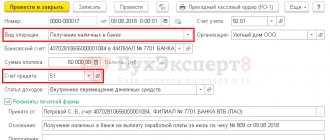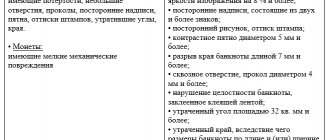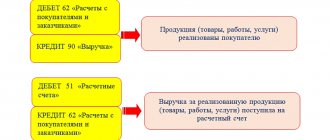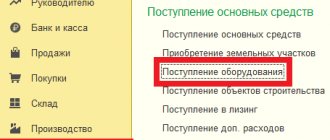All cash transactions are periodically audited and all valuables are checked. The inspection is carried out by the organization's inventory commission. Its members, in the presence of a responsible person, check the availability of money, receipts for deposited valuables, check books and strict reporting forms. Inconsistencies identified during inspections are documented in accounting acts. For more details on how a shortage is determined at the cash register, the entries that must be indicated in the balance sheet if it is detected, read on.
Values
The cash desk at an enterprise may contain cash, payment documents, securities and strict reporting forms. Payment documents include not only receipts, but also stamps (postal, bill and state duties), vouchers to sanatoriums, air tickets and other documents. Strict reporting forms include: receipts, certificates, diplomas, subscriptions, tickets, coupons, shipping documents, etc. The cashier bears financial responsibility for the preservation of monetary documents.
Surplus cash identified during cash inventory
Excess funds must be capitalized and included in other income (clause 5.1 of the Methodological Instructions for Inventory of Property and Financial Liabilities, approved by Order of the Ministry of Finance dated June 13, 1995 N 49):
- debit account 50 – credit account 91.
For tax purposes, it is also necessary to recognize non-operating income (Clause 20, Article 250 of the Tax Code of the Russian Federation). It is reflected on the date of registration of the inventory results (clause 1 of Article 271 of the Tax Code of the Russian Federation).
Accounting is one of the key links in the work of any enterprise. Competent, clean, highly qualified accounting support guarantees the smooth operation of the company, while an unprofessional accountant can jeopardize the entire organization. That is why the work of accounting in any enterprise needs to be given special attention. And separately, the management of the enterprise should keep control over compliance with cash discipline. It is cash discipline that will be discussed in this material.
Inventory
The procedure for carrying out cash inventory is regulated by the “Procedure for maintaining the cash register No. 40”, approved by the Board of Directors of the Central Bank of the Russian Federation, and Letter of the Central Bank No. 18 dated 04.10.93.
The timing of the inspection at the enterprise is established by the manager and enshrined in the order. The inventory is carried out by a specially created commission, which includes representatives of the administration, the chief accountant and the cashier.
Before carrying out the procedure, prepares a cash report. It includes all primary documents that should be at the cash desk. If the inventory reveals unclosed statements (for salary payments), then all unpaid amounts are equated to cash. The amounts paid are recorded separately in the document.
The cashier is required to provide a receipt stating that by the time the inventory begins, payment documents have been submitted to the accounting department, and all cash has been recorded. This must be done so that upon completion of the check the cashier does not declare that he has payment documents. The cashier's report is checked against the information in the cash book and the order.
To conceal the fact of embezzlement of funds, receipts are often used as documents. But they cannot confirm the expenditure of funds, since they are not drawn up in a unified form and do not contain the signatures of the recipient, the chief accountant and the manager. If such documents exist, then it is considered that a shortage was identified during the inventory of the cash register. The entry must be made in the balance sheet on the date of the audit. The chairman of the commission endorses all orders and attaches them to the report. This document serves as the basis for recording fund balances.
Reflection in postings of surpluses and shortages in the cash register
The organization's cash desk is designed to store funds, strict reporting forms, bills and other monetary documents. Inventory is a tool for identifying surpluses and shortages in the organization's cash register. How to formalize the results of the inventory, what transactions are generated when surpluses or shortages are identified at the cash register - we will consider further.
Cash audit rules
The cash register inventory is carried out at a frequency established by order of management and enshrined in the accounting policy of the enterprise. The same regulations establish the inventory procedure. The cashier is recognized as the financially responsible person for the cash register.
Before the inventory, the manager (director) issues an order (order), which indicates the start date and composition of the inspection commission.
The commission must include at least three people. The presence of the MOL on the commission's list is mandatory. In addition, the presence of security and internal audit employees (if available) is desirable. If there is no signature of even one of the commission members, the inventory is considered invalid.
Before checking, the cashier stops all operations and generates a cash report.
Example of a cash report
This report reflects all incoming and outgoing orders, which, in addition, must comply with the approved forms. Identified missing or excess amounts are reflected in accounting during the audit period.
During the inventory the following is also checked:
Get 267 video lessons on 1C for free:
- Setting a limit on the balance of DS at the cash desk;
- Inconsistency between the dates of cash receipts and the actual issuance of money;
- Correctness of correspondence of cash document accounts;
- Whether unpaid wages were deposited on time.
Based on the results of the inventory, an inventory report INV-15 is drawn up. In commercial organizations, surpluses and shortages are written off to the financial result.
Unscheduled audit of the cash register
The cash register inventory can be carried out unscheduled, suddenly and without warning, in order to control the responsibility of the MOL. The timing and procedure for unscheduled inventory are also established by the regulations of the enterprise.
Reflection of surplus
The discovery of surpluses based on the results of a cash register inventory does not have any consequences for the financially responsible person.
Example
In Margaritka LLC, as a result of a cash inventory, a surplus in the amount of 1,050 rubles was discovered.
The accountant makes entries according to the identified surpluses:
| Dt | CT | Operation description | Amount, rub. | Document |
| 50 | 91.1 | Reflection of surplus DS at the cash desk | 1 050 | Accounting information |
That is, the detected surplus amounts are included in non-operating income.
Reflecting shortages
The identified amounts of shortages, until their culprits are clarified, are accounted for in account 94 “Shortages and losses from damage to valuables.” Shortages that cannot be attributed to specific sources are written off to non-operating expenses.
Examples
LLC Nord-West, based on the results of the inventory in March 2016, revealed a shortage in the cash register in the amount of 550 rubles.
The accountant of Nord-West LLC makes an entry for the identified shortage in the cash register:
| Dt | CT | Operation description | Amount, rub. | Document |
| 94 | 50 | The amount of the shortage is reflected | 550 | Accounting certificate, INV-15 |
The culprit of the shortage was not discovered and it was decided to write off this amount as non-operating expenses. Generated postings:
| Dt | CT | Operation description | Amount, rub. | Document |
| 91.2 | 94 | The shortfall is written off as expenses | 550 | Accounting information |
In April, a shortage of 1,000 rubles was again recorded. This time it was decided to attribute the damage to the cashier's account. Postings in this case:
| Dt | CT | Operation description | Amount, rub. | Document |
| 94 | 50 | The amount of the shortage is reflected | 1 000 | INV-15, accounting certificate |
| 73.2 | 94 | The missing amount is written off for settlements with responsible persons | 1 000 | Accounting information |
| 50 | 73.2 | The deficiency was repaid by the responsible person | 1 000 | Receipt cash order |
Source: https://BuhSpravka46.ru/buhgalterskie-provodki/otrazhenie-v-provodkah-izlishkov-i-nedostach-v-kasse.html
Peculiarities
During the inventory you need to check:
- whether the cash balance in the cash register exceeded the established limit;
- targeted use of funds;
- correspondence of the date of the transaction in the cash register and the debit order;
- validity of records;
- timely return of unpaid salary balances to the account;
- correctness of paperwork;
- presence of signatures of the director, chief accountant on blank checks;
- the fact of keeping the checkbook outside the cash register;
- legality of transactions carried out within one transaction;
- correctness of correspondence invoices.
When can a deficiency be detected?
Inventory of the company's cash register is carried out at intervals established by order of the manager. It is mandatory to check assets and liabilities by all enterprises, including before drawing up accounting forms, that is, at the end of the year (Article Law No. 402-FZ dated 12/06/11, clause of Order of the Ministry of Finance No. 34n dated 07/29/98 G.).
As a result of inventory activities, both shortages and surpluses of valuables can be detected. In the first case, negative discrepancies are revealed between accounting indicators and the actual amount of funds in the cash register, in the second – positive ones. Which person is considered responsible for the detected shortage?
Cash recount
The availability of funds in the cash register is confirmed by a sheet-by-sheet count of cash, securities and monetary documents. The cashier carries out the recount in the presence of members of the commission. Money is calculated for each bill separately, starting with the highest denomination. If there is a large number of banknotes, then an inventory is drawn up indicating the denomination and number of banknotes. This document is signed by the commission. If there is a shortage of funds, then a shortage has been identified at the cash register. Posting to accounting using account 50 “Cash” confirms this fact.
Is the cashier obligated to compensate for shortfalls in the cash register?
The position of a cashier involves enormous responsibility, but the responsibilities in this profession must be precisely correlated with the rights. Both excess and shortage are not always the fault of the cashier, since there are many situations that can lead to a difference between the amount at the cash register and the settlement amount.
In any case, the cashier, as a financially responsible person, is obliged to pay for his miscalculations from his own pocket. If there is a minus at the cash register, the cashier must fully reimburse the missing amount. These actions are regulated by articles 242 and 243 of the Labor Code of the Russian Federation. The reason for the shortage in the cash register is not important - whether the employee made a mistake accidentally or intentionally, he must compensate for the damage.
Did you know?
If the amount of the shortfall is less than the employee’s monthly salary, then the employer can recover it without the consent of the person who was at fault.
Financial penalties are not the only type of punishment for improper performance of work duties. In accordance with Articles 192 and 193 of the Labor Code, the employer has the right to take disciplinary action against a negligent employee. This could be a warning, a reprimand, and in extreme cases, dismissal. Of course, an adequate leader must weigh the pros and cons before making a fateful decision.
Recalculation of forms
The actual availability of Central Bank forms and reporting documents is carried out by name, type and category of forms. For example, shares can be registered, bearer, interest-bearing and ordinary. During the check, the starting and ending numbers of the forms, their series and cost are also recorded.
All these monetary documents are registered based on the results of the inventory in the amount of expenses for their acquisition. The balance of the forms is determined based on the data in the cash book or report. If a shortage of forms is detected, the shortage is registered at the cash desk. Accounting entries are made according to analytical and synthetic accounting accounts. Examples of registration of such operations will be presented below.
Accounting and posting - postings
A copy of the INV-15 act is sent to the accounting department to perform the necessary accounting actions. The accountant makes the necessary postings (account correspondence).
Cash surpluses are recorded by accounting in the month of completion of the relevant check and, if an inventory was carried out, are accounted for on the date of acceptance of the detected cash.
If an annual audit was carried out, its results are reflected in the annual reports.
Identified excess cash in the cash register is reflected in accounting entries using the following entries:
| Operation (description) | Debit | Credit |
| Reflects cash revenue identified upon verification of cash register systems. | 50 | 90 |
| Cash surplus is capitalized as other income of the organization | 50 | 91 |
Shortage at the cash desk: postings
At enterprises, cash is accounted for in account 50 “Cash”, which has three sub-accounts: 50-1 “Cash of the enterprise”, 50-2 “Operating cash”, 50-3 “Payment documents”. Reporting forms on the off-balance sheet account 006 of the same name are taken into account separately.
Identified surplus funds are subject to capitalization under the item of non-operating income. The entry DT50-1 KT91-1 is made in the control unit.
The shortage of funds in the cash register is reflected by posting using account 94 in the DT for the amount of actual expenses. Let's look at typical wiring:
— DT94 KT006 – lack of forms.
— DT94 KT50-1(50-3) – lack of money in the cash register.
Posting DT73-2 KT94 reflects the write-off of the shortage to the cashier. Compensation for damage from an employee's salary is reflected in the entry DT70(50) KT73-2.
In the absence of a guilty person, how is the shortage reflected in the cash register? Postings:
— DT94 KT50-1 – fact of identifying a shortage of funds;
— DT91-2 KT94 — the amount of the shortage is included in non-operating expenses.
Types of liability for shortages
- Full financial responsibility. This implies reimbursement of the entire missing amount at the expense of the cashier. If the amount that needs to be reimbursed is no more than the average monthly salary of the culprit, then he must reimburse it by order of management, issued no later than a month from the date of discovery of the shortage. Large sums can only be recovered through judicial proceedings. The employer has a year to go to court on this matter.
- Administrative penalty. The cashier, through his action, inaction or negligence, violated the procedure for handling cash, which means he may be subject to administrative liability. Officials can pay 4–5 thousand rubles, and legal entities – 40–50 thousand rubles. - this is in addition to compensation for the amount of the shortfall itself.
- Disciplinary action. May also be imposed by the employer, in addition to damages. A careless cashier can be reprimanded, reprimanded, and in some cases fired without mercy.
- Criminal liability. Threatens those officials in respect of whom the intent of their actions has been proven. Such guilty actions are recognized as:
- theft - secret appropriation of someone else's property;
- fraud - the acquisition of rights to someone else's funds due to abuse of trust or deception;
- embezzlement – theft of entrusted property or funds and subsequent sale, use, transfer to third parties;
- misappropriation – unlawful retention of entrusted assets for one’s use.
ATTENTION! You will have to file a claim in court if the cashier does not agree to voluntarily pay the funds, as well as after the expiration of the established month.
These actions are punished, depending on the severity, the possibility of relapse and the category of the guilty employee, either by a fine, or by compulsory or correctional labor, or by restriction of freedom, arrest or prison. The specific time limits depend on the type of criminal act.
Criminal liability for lack of money in the cash register
| № | Type of offense | Sanction | Term, amount |
| 1. | Theft | Fine | Up to 80,000 rub. or in the amount of salary or income for six months |
| Mandatory work | Up to 180 hours | ||
| Correctional work | From six months to a year | ||
| Restriction of freedom | Up to 2 years | ||
| Arrest | From 2 to 4 months | ||
| Deprivation of liberty | Up to 2 years | ||
| 2. | Fraud | Fine | Up to 120,000 rub. or in the amount of an annual salary or other income |
| Mandatory work | Up to 180 hours | ||
| Correctional work | From 6 months to a year | ||
| Restriction of freedom | Up to 2 years | ||
| Arrest | From 2 to 4 months | ||
| Deprivation of liberty | Up to 2 years | ||
| 3 | Embezzlement, misappropriation | Fine | Up to 120,000 rub. or in the amount of annual income |
| Mandatory work | Up to 120 hours | ||
| Correctional work | Up to six months | ||
| Restriction of freedom | Up to 2 years | ||
| Deprivation of liberty | Up to 2 years |
IMPORTANT INFORMATION! For any act that provides for criminal liability, the perpetrator can be dismissed at the initiative of the employer.
Checking operating cash registers
For settlements with company employees, operating cash desks are used. The procedure for checking them differs from that described above.
The commission, in the presence of the cashier, records meter readings that reflect the amount of revenue. The data is checked against the submitted cash register tape. The difference in the balance at the beginning and end of the day reflects the daily amount of revenue. The numbers in the cash book, on the tape and on the counters must be identical.
Cash recalculation is carried out using the purchase method. The resulting balance is compared with the accounting balance. Based on the results of the inventory, a shortage of funds in the cash register may be identified. The posting, which in this case is entered into the balance sheet, looks like this: DT94 KT50-2.
How to account for shortages
To account for shortages, account 94 “Shortages and losses from damage to valuables” is intended. This account summarizes information on the amounts of shortages and losses from damage to material and other assets (including cash) identified in the process of their procurement, storage and sale.
The shortage of property discovered during the inventory is reflected in the debit of account 94 from the credit of the accounts:
- 01 “Fixed assets”;
- 08 “Investments in non-current assets”;
- 10 "Materials";
- 41 "Products";
- 43 “Finished products”;
- 50 "Cash desk" and others.










